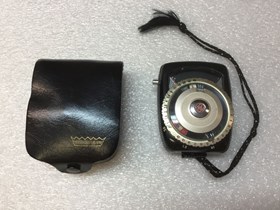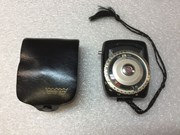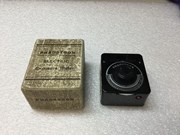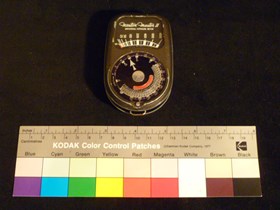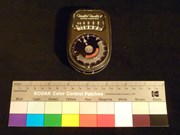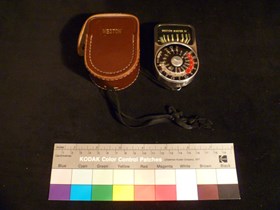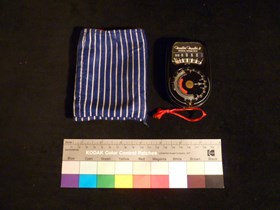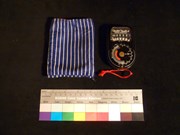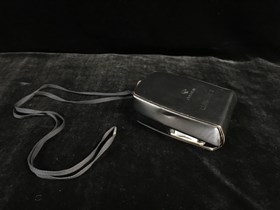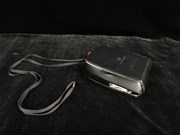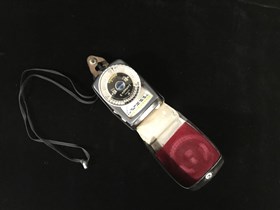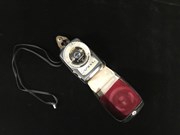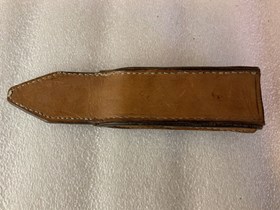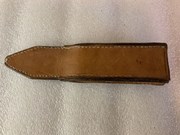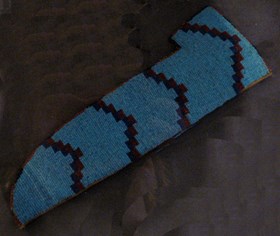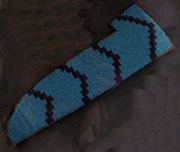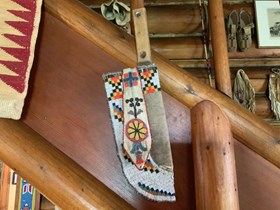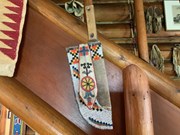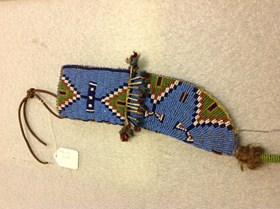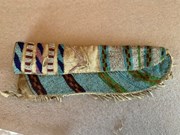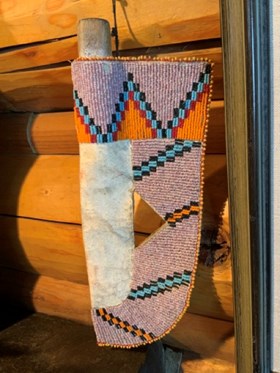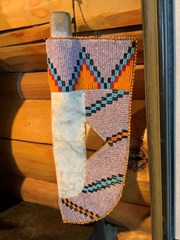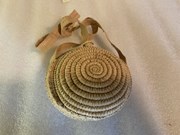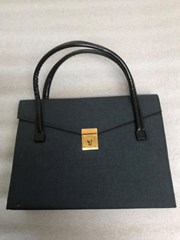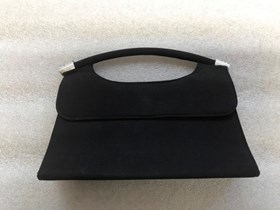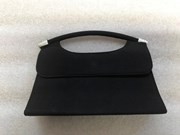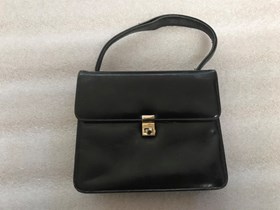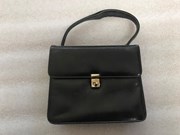Narrow Results By
- Photograph 29320
- Negative 17296
- Library - Book (including soft-cover and pamphlets) 14731
- Transparency 3187
- Library - Periodical 3157
- Library - Postcard 2944
- Textual record 2864
- Lantern slide 2559
- Map 2131
- Photograph print 2130
- Library - Maps and blueprints (unannotated; published) 1823
- Graphite Drawing 1627
- Date
- n.d.
- Material
- metal; paper; plastic
- Catalogue Number
- 104.41.1305 a-e
- Description
- a) open face pocket watch shaped meter with a metallic body and two dials showing through the cover glass; milled edge rings that revolve for exposure adjustment; small orange glass disc mounted on top of the cover glass to protect the sensitive paper segment; label at the centre of the instrument’…
1 image
- Title
- Exposure Meter
- Date
- n.d.
- Material
- metal; paper; plastic
- Dimensions
- 2.0 x 5.5 x 8.0 cm
- Description
- a) open face pocket watch shaped meter with a metallic body and two dials showing through the cover glass; milled edge rings that revolve for exposure adjustment; small orange glass disc mounted on top of the cover glass to protect the sensitive paper segment; label at the centre of the instrument’s face, in black print against a white background: “Wynne’s “Infallible” Exposure Meter”; smallest concentric dial is labelled: “ACTINOMETER / TIME AND EXPOSURE IN SECONDS OR MINUTES.”; the calibration ranges from 1/128 to 64; the largest concentric dial is labelled: “DIAPHRAGMS AND PLATE SPEED NOS” and its calibration ranges from F4 to F362; on the back, “EXCEPTIONAL SUBJECTS” exposures are engraved: “SEA AND SKY 1/10 / DITTO WITH SHIPS 1/4 / SNOW SCENES 1/4 / WHITE STATUARY 1/4 / LIGHT FOREGROUND 1/2 / PORTRAITS NEAR CAMERA 1 1/2 / DARK OBJECTS DITTO 2”; a curly bracket on the list right side is labelled vertically: “NORMAL EXPOSURE”b) original rectangular golden tin case with red print label on lid: “WYNNE’S “INFALLIBLE” / PHOTOGRAPHIC / EXPOSURE METER /AN UNERRING GUIDE TO / THE CORRECT EXPOSURE REQUIRED FOR EVERY SPEED OF PLATE, ON EVERY KIND OF SUBJECT, AND UNDER EVERY CONDITION OF LIGHT / THE “INFALLIBLE” / EXPOSURE METER COMPANY, / WREXHAM.”; tiny hole pierced in the viewer’s right hand side with a golden metallic piece of wire poking through, held in place by loops formed at each endc) 32-pages long instruction manual with green cover; text on front cover in black print placed inside a wiggly rectangular frame: “The true progress of Invention is towards simplicity.” / What the watch is to find the correct time of day, / The “Infallible” Exposure Meter is to find the correct time of exposure. / You set the scale, it does the rest. / WYNNE’S “Infallible” / Photographic Exposure Meter / IS AN UNERRING GUIDE TO / The correct exposure required for every speed of plate on every kind of subject, and under every condition of light. / The “Infallible” / Exposure Meter Company, Wrexham.”; sections include the “four conditions which govern exposure”: “ 1- The intensity of the light which illuminates the subject. / 2- The Diaphragm or Stop employed. / 3- The character of the subject to be photographed. / 4- The sensitiveness of the plate used.” followed by: “TO CALCULATE THE CORRECT EXPOSURE / PHOTOGRAPHING EXCEPTIONAL SUBJECTS / PLATE SPEED NUMBERS / INSTANTANEOUS PHOTOGRAPHS / INTERIORS / ENLARGEMENTS / SIMPLICITY OF INSTRUMENT / DIRECTIONS AS TO USE OF METER”d) square red paper envelope; text in black print on front: “Rapid Deadmatch Paper” underlined, followed by description: “New and Perfected Sensitive Paper for Wynne’s Infallible Exposure Meter. / Price 6d Per Packet. / Open only in a Weak or Artificial Light. / Remove contents and put in bottom of Meter Case. / THE INFALLIBLE EXPOSURE METER CO., / Wrexham.”; contains 4 circles of sensitive papere) yellowed car leaflet folded in three; text on front: “May, 1913. / Latest List of SPEED PLATES” with drawn illustration of the exposure meter followed by list of plate brand and their corresponding F-stop
- Subject
- Nicholas Morant
- photography
- Credit
- Gift of Nicholas Morant, Banff, 2006
- Catalogue Number
- 104.41.1305 a-e
Images
This material is presented as originally created; it may contain outdated cultural descriptions and
potentially offensive content.
Read more.
Exposure Meter
https://archives.whyte.org/en/permalink/artifact104.41.0141
- Date
- 1955 – 1958
- Material
- metal; plastic; leather; fabric
- Catalogue Number
- 104.41.0141
- Description
- A General Electric Exposure Meter (type PR-3) in a black leather pouch. The meter has several dials on the front in order to set the exposure, a silver metal button on the left-hand side, a brief instruction plate attached to the back, and a black and gold fabric cord attached to the bottom. It is …
1 image
- Title
- Exposure Meter
- Date
- 1955 – 1958
- Material
- metal; plastic; leather; fabric
- Dimensions
- 3.4 x 6.7 x 8.2 cm
- Description
- A General Electric Exposure Meter (type PR-3) in a black leather pouch. The meter has several dials on the front in order to set the exposure, a silver metal button on the left-hand side, a brief instruction plate attached to the back, and a black and gold fabric cord attached to the bottom. It is mostly made of black plastic - the dials on the front and instruction plate on the back are both metal. The leather pouch has a front flap that snaps closed at the bottom and is mostly open on the inside so as to access the meter’s dials - there are openings on the left-hand side and the bottom for the button and cord. In the bottom right corner of the front flap is an embossed gold crown.
- Credit
- Gift of Nicholas Morant, Banff, 2006
- Catalogue Number
- 104.41.0141
Images
This material is presented as originally created; it may contain outdated cultural descriptions and
potentially offensive content.
Read more.
Exposure Meter
https://archives.whyte.org/en/permalink/artifact104.41.0195
- Date
- 1940 – 1941
- Material
- plastic; metal; cardboard;
- Catalogue Number
- 104.41.0195
- Description
- Black plastic hand-held exposure meter with a metal and plastic dial with a raised knob on the front below a depressed window where the exposure meter is. On the bottom of the meter just below the main dial is the exposed lip of the metal dial so that it can be rotated and a small round red plastic…
1 image
- Title
- Exposure Meter
- Date
- 1940 – 1941
- Material
- plastic; metal; cardboard;
- Dimensions
- 5.2 x 7.2 x 9.2 cm
- Description
- Black plastic hand-held exposure meter with a metal and plastic dial with a raised knob on the front below a depressed window where the exposure meter is. On the bottom of the meter just below the main dial is the exposed lip of the metal dial so that it can be rotated and a small round red plastic button. On the back of the meter is a metal screw in the middle [possibly to allow access to the interior], manufacturer details, and a thin strip of fabric adhesive with F.L. Crosby’s address details typed on it in black. The cardboard box has a patterned brown and white lid that fits completely over a beige body and is lined with packing cardboard.
- Credit
- Gift of Robert Crosby Family, Banff, 1998
- Catalogue Number
- 104.41.0195
Images
This material is presented as originally created; it may contain outdated cultural descriptions and
potentially offensive content.
Read more.
Exposure Meter
https://archives.whyte.org/en/permalink/artifact104.41.0221
- Date
- n.d.
- Material
- metal; plastic; paint; leather
- Catalogue Number
- 104.41.0221
- Description
- Hand held exposure/light meter made by Weston Electrical Instrument Company in a black metal finish housed in a brown leather case and a long black strap.In the top of the exposure meter there is a clear plastic covering. Along the very top there us the name of the manufacturer in white cursive let…
1 image
- Title
- Exposure Meter
- Date
- n.d.
- Material
- metal; plastic; paint; leather
- Dimensions
- 2.9 x 7.0 x 10.0 cm
- Description
- Hand held exposure/light meter made by Weston Electrical Instrument Company in a black metal finish housed in a brown leather case and a long black strap.In the top of the exposure meter there is a clear plastic covering. Along the very top there us the name of the manufacturer in white cursive lettering that reads “Weston Master II” and written underneath in capital letters “UNIVERSAL EXPOSURE METER.” Below this is the light scale where the value of the scene would be indicated. The scale contains the values “0” “25” “50” “100” “200” “400” “800” “1600,” which means that the two values on this instrument are calibrated 0-50 and 0-1600. (candles per square foot.)Below there is a circular face with several figures and a dial that turns/rotates. The outside row of figures on the exposure control dial represents the light value settings and corresponds to the light values on the light scale. Below the round dial there is a tiny circular button that is used to set the exposure control dial for film speed. As the dial turns it reveals the “EMULSION SPEED” with a red baize finish that has become worn throughout its life. The row of figures at the bottom of the top dial is the f/stop values and has an “f” to make this more apparent for the user. The row of figures directly below the f/stop settings are the shutter speeds. After setting the exposure control dial to the light value obtained on the light scale, any of the combinations of f/stop and shutter speed directly opposite each other are correct. On the rear of the meter there is a black plastic covering that contains several circular cut outs that are called a hir.ged baffle. This can be swung open (against the case) using the gold latch, which clips into a tiny hole or socket when the user wishes it to be closed. When opened the light sensitive photo cell is directly beneath this baffle and contains several protruding circles. When the baffle is open, the scale range is 0-50; when the baffle is closed, the scale range is 0-1600. Below there is an oval shaped face with extensive information that is held in place with two small screws on both the viewer left and right side. There is silver lettering on a black background that reads “WESTON ELEC. INST. CORP.” “NEWARK, N.J., U.S.A.” A silver backing separates the patent information and has black writing that reads “MODEL 735” on the viewer left side. On the viewer right side the number “7454510” is engraved. In the middle there is a gold-coloured screw with the words “ZERO CORRECTOR” written in black. Below this there is the patent information; “U.S. PATENTS” “2,274,441” “2,073,790” “2,346,555” “2,137,466” “2,463,770.” Below these numbers are the “FOREIGN PATENTS” “FRENCH 862,770” “BRITISH 531,996” “CAN. 347,085” “CAN. 411,975” At the very bottom underneath there is the manufacturer’s location; “MADE IN U.S.A”The brown leather case fits snuggly around the meter, with a metal clasp that allows both sides of the meter to be seen. On the front of the case in the top middle is a stamp that reads “SERVICE” and a simple illustration of a man walking with a rectangle. On the reverse side is a space for an identification card that is empty but has sections for name, address, and phone number.
- Subject
- photography
- equpiment
- Credit
- Gift of Dan MacDonald, Calgary, 1993
- Catalogue Number
- 104.41.0221
Images
This material is presented as originally created; it may contain outdated cultural descriptions and
potentially offensive content.
Read more.
Exposure Meter
https://archives.whyte.org/en/permalink/artifact104.41.1118
- Date
- 1888
- Material
- metal; paint; plastic
- Catalogue Number
- 104.41.1118
- Description
- Hand held exposure/light meter made by Weston Electrical Instrument Company in a grey metal finish. Along both sides of the meter are a series of protruding lines that allow one to safely grip the object. At the bottom of the artifact there is a metal hook, which would have allowed a string to be a…
1 image
- Title
- Exposure Meter
- Date
- 1888
- Material
- metal; paint; plastic
- Dimensions
- 2.0 x 6.0 x 9.5 cm
- Description
- Hand held exposure/light meter made by Weston Electrical Instrument Company in a grey metal finish. Along both sides of the meter are a series of protruding lines that allow one to safely grip the object. At the bottom of the artifact there is a metal hook, which would have allowed a string to be attached like on the other Weston meter’s owned by Nicholas. There is also no longer a case to protect this particular object. In the top of the exposure meter there is a clear plastic covering. Along the very top there us the name of the manufacturer in white cursive lettering that reads “Weston Master II” and written underneath in capital letters “UNIVERSAL EXPOSURE METER.” Below this is the light scale where the value of the scene would be indicated. The scale contains the values “0” “25” “50” “100” “200” “400” “800” “1600,” which means that the two values on this instrument are calibrated 0-50 and 0-1600. (candles per square foot.)Below there is a circular face with several figures and a dial that turns/rotates. The outside row of figures on the exposure control dial represents the light value settings and corresponds to the light values on the light scale. Below the round dial there is a tiny circular button that is used to set the exposure control dial for film speed. As the dial turns it reveals the “EMULSION SPEED” with a red baize finish that has become worn throughout its life. The row of figures at the bottom of the top dial is the f/stop values and has an “f” to make this more apparent for the user. The row of figures directly below the f/stop settings are the shutter speeds. After setting the exposure control dial to the light value obtained on the light scale, any of the combinations of f/stop and shutter speed directly opposite each other are correct. On the rear of the meter there is a black plastic covering that contains several circular cut outs that are called a hir.ged baffle. This can be swung open (against the case) using the gold latch, which clips into a tiny hole or socket when the user wishes it to be closed. When opened the light sensitive photo cell is directly beneath this baffle and contains several protruding circles. When the baffle is open, the scale range is 0-50; when the baffle is closed, the scale range is 0-1600. Below there is an oval shaped face with extensive information that is held in place with two small screws on both the viewer left and right side. There is silver lettering on a black background that reads “WESTON ELEC. INST. CORP.” “NEWARK, N.J., U.S.A.” A silver backing separates the patent information and has black writing that reads “MODEL 735” on the viewer left side. On the viewer right side the number “7454510” is engraved. In the middle there is a gold-coloured screw with the words “ZERO CORRECTOR” written in black. Below this there is the patent information; “U.S. PATENTS” “2,274,441” “2,073,790” “2,346,555” “2,137,466” “2,463,770.” Below these numbers are the “FOREIGN PATENTS” “FRENCH 862,770” “BRITISH 531,996” “CAN. 347,085” “CAN. 411,975” At the very bottom underneath there is the manufacturer’s location; “MADE IN U.S.A.”
- Subject
- photography
- Nick Morant
- Credit
- Gift of Nicholas Morant, Banff, 2006
- Catalogue Number
- 104.41.1118
Images
This material is presented as originally created; it may contain outdated cultural descriptions and
potentially offensive content.
Read more.
- Date
- 1888
- Material
- leather; metal; nylon; plastic; thread; paint
- Catalogue Number
- 104.41.1119 a-b
- Description
- Hand held light meter in a pear shape with a stainless steel body and leather case. Along both sides of the meter are a series of protruding lines that allow one to safely grip the object. On the viewer right there is a pointer lock, which is locked when positioned upwards and released when positio…
1 image
- Title
- Exposure Meter
- Date
- 1888
- Material
- leather; metal; nylon; plastic; thread; paint
- Dimensions
- 2.0 x 5.0 x 9.0 cm
- Description
- Hand held light meter in a pear shape with a stainless steel body and leather case. Along both sides of the meter are a series of protruding lines that allow one to safely grip the object. On the viewer right there is a pointer lock, which is locked when positioned upwards and released when positioned downward. At the bottom of the artifact there is a metal hook, which has a black string running through. In the top of the light meter there is clear plastic covering. Written in capital letters is “WESTON MATER IV” above the light scale. The lights scale contains the numbers “0” “25” “50” “100” “200” “400” “800” “1600,” which means that the 2 values calibrated on this instrument are 0-50 and 0-1600.Below there is another light scale in the form of a circular face with several figures and a dial that turns/rotates. The dial on the outside has a series of protruding lines to make movement easier and contains a row of figures. This dial controls the lens aperture (f/stop) scale and has a series of values representing the focal length of the lens; “1” “1.4” “2” “2.8” “4” “5.6”. On the same dial there is also the letters “EVS,” which stands for the exposure value setting with a cut out window that reveals the EVS values. Working in a clockwise direction (on the same dial) there is also the letters “U,” “A with “1/2” over top,” an enclosed arrow that is known as the normal arrow, a “C” with “2x” on top of it, and a “0”. As this dial is turned it reveals a partly red baize and black numbers on a silver background that represents the shutter speeds in fractions of seconds. The inside dial has a series of light scale values and an exposure index window that line up with the “U,” “A,” normal arrow, “C,” and “0.” On the opposite side of the exposure index window is the exposure index knob. On the rear of the meter there is a black plastic covering that contains several circular cut outs that are called a hir.ged baffle. This can be swung open (against the case) using the gold latch, which clips into a tiny hole or socket when the user wishes it to be closed. When opened the light sensitive photo cell is directly beneath this baffle and contains several protruding circles. When the baffle is open, the scale range is 0-50; when the baffle is closed, the scale range is 0-1600. Below there is an oval shaped face with extensive information that is held in place with two small screws on both the viewer left and right side. There is black lettering on a silver background that reads “UNIVERSAL EXPOSURE METER” “MODEL 745” SER.W” and “107522” engraved. Below the manufacturer information is listed; “DAYSTROM. INCORPORATED” “WESTON INSTRUMENTS DIVISION”. “NEWARK. N.J.. U.S.A.” In the middle there is a gold-coloured screw with the words “ZERO CORRECTOR” written in black. On the viewer left side of the zero corrector there is patent information; “U.S. PATENTS” “2463770” and on the viewer right side “FOREIGN PATS” “CAN. 411975”. At the very bottom on either side of a circular cut out are “ASA” and “K=1.0” written. Underneath “MADE IN JAPAN” has also been written.There is also a brown leather case with this object. The front has “WESTON” written in gold letters. On the viewer left there is a brown button that allows the case to be opened or fastened shut. The leather has been stitched together with light brown thread that is visible. The bottom of the case has an opening for the black string to be strung through so that the light meter and case are attached. On the rear there is a brown leather strap stitched.
- Subject
- photography
- Nick Morant
- Credit
- Gift of Nicholas Morant, Banff, 2006
- Catalogue Number
- 104.41.1119 a-b
Images
This material is presented as originally created; it may contain outdated cultural descriptions and
potentially offensive content.
Read more.
- Date
- 1888
- Catalogue Number
- 104.41.1120 a-b
- Description
- Hand held light meter in a pear shape with a stainless steel body and leather case. Along both sides of the meter are a series of protruding lines that allow one to safely grip the object. At the bottom of the artifact there is a metal hook, which has a red string running through.There is a clear p…
1 image
- Title
- Exposure Meter
- Date
- 1888
- Description
- Hand held light meter in a pear shape with a stainless steel body and leather case. Along both sides of the meter are a series of protruding lines that allow one to safely grip the object. At the bottom of the artifact there is a metal hook, which has a red string running through.There is a clear plastic covering located at the top of the meter. Written in cursive letters is the company name “WESTON MATER II”. Underneath this written in capital letters is “UNIVERSAL EXPSOURE METER”. The light scale underneath contains the numbers “0” “25” “50” “100” “200” “400” “800” “1600,” which means that the 2 values calibrated on this instrument are 0-50 and 0-1600. Underneath the scale the word “Light” is present. Below there is another light scale in the form of a circular face with several figures and a dial that turns/rotates. The outside row of figures on the exposure control dial represents the light value settings and corresponds to the light values on the light scale at the top. The row of figures at the bottom of the top dial is the f/stop values and has an “f” to make this more apparent for the user.. On the same dial there is silver letters that have a line that correspond to the figures on the outside dial; “U,” “A with “1/2” underneath,” an arrow that is known as the normal arrow, a “C” with “2x” below it, and a “0”. As this dial is turned it reveals a partly red baize and the emulsion speed, which is self-evident as the words “EMULSION SPEED” are present. The row of figures directly below the f/stop settings are the shutter speeds. The outside row of figures is the light values, which is apparent as the word “LIGHT” with an arrow points to these values. After setting the exposure control dial to the light value obtained on the light scale, any of the combinations of f/stop and shutter speed directly opposite each other are correct. Below the round dial there is a tiny circular button that is used to set the exposure control dial for film speed.On the rear of the meter there is a black plastic covering that contains several circular cut outs that are called a hir.ged baffle. This can be swung open (against the case) using the gold latch, which clips into a tiny hole or socket when the user wishes it to be closed. When opened the light sensitive photo cell is directly beneath this baffle and contains several protruding circles. When the baffle is open, the scale range is 0-50; when the baffle is closed, the scale range is 0-1600. Below there is an oval shaped face with extensive information that is held in place with two small screws on both the viewer left and right side. There is silver lettering on a black background that reads “WESTON ELEC. INST. CORP.” “NEWARK, N.J., U.S.A.” A silver backing separates the patent information and has black writing that reads “MODEL 735” on the viewer left side; “No” is present in the middle; “8284703” is engraved on the viewer right side. In the middle there is a brass screw with the words “ZERO CORRECTOR” written in black around its circumference. On the viewer left side of the zero corrector is the patent information; “U.S. PATENTS” “1,779,574” “1,982,406” “2,073,790” and on the viewer right side continued patent information “U.S. PATENTS” “2,137,466” “2,274,441” “2,346,555”. Below these numbers are the “FOREIGN PATENTS” “FRENCH 862,770” “BRITISH 531,996” “CAN. 347,085” “CAN. 411,975” At the very bottom underneath there is the manufacturer’s location; “MADE IN U.S.A.” written in black on a silver background.There is also a blue case with white stripes and a red inner lining that would be used to protect the case. This would not have been originally sold with the exposure meter and was most likely hand made in an effort to protect the meter. Blue stitches hold the fabric together and are visible.
- Subject
- photography
- Nick Morant
- Credit
- Gift of Nicholas Morant, Banff, 2006
- Catalogue Number
- 104.41.1120 a-b
Images
This material is presented as originally created; it may contain outdated cultural descriptions and
potentially offensive content.
Read more.
- Date
- 1933 – 1949
- Material
- plastic; paint; leather; metal; fabric
- Catalogue Number
- 104.41.1123 a-b
- Description
- (a)Gossen Lunasix exposure and colour meter in a pear shape with leather case. The light meter device measures the amount of light that is appropriate to achieve the proper exposure, indicating for the users which shutter speed and f-number should be selected. Along the top of the exposure meter in…
1 image
- Title
- Exposure Meter
- Date
- 1933 – 1949
- Material
- plastic; paint; leather; metal; fabric
- Dimensions
- (a)2.5; (b)04.5 x (a)6.5; (b)7.5 x (a)11.5; (b)12.0 cm
- Description
- (a)Gossen Lunasix exposure and colour meter in a pear shape with leather case. The light meter device measures the amount of light that is appropriate to achieve the proper exposure, indicating for the users which shutter speed and f-number should be selected. Along the top of the exposure meter in the viewer left corner is a white bulb-like part next to an open circular window that measures the amount of light present in the scene. When the converter slide, located along the viewer right side, is moved to the right and clicked into position the round window is open and ready to read the scene. At the top, on the face of the meter, the light measurement (scale) is present. This shows how much light is present in the scene and directly relates to the remaining scales on the meter. Below the light scale is a plexiglass film-speed setting disc with grooves that allow the operator to easily move the dial. In the middle of the dial there is the Lunasix manufacturer symbol. On viewer left side of this emblem is the DIN exposure index of the film in use; on the proper right side of this emblem is the ASA exposure index of the film in use. By moving the dial one adjusts the film-speed setting, which is indicated in the DIN and ASA boxes, whereby the index number is lined up against the triangular white marker in the respective window. A manual would have originally been sold with the object giving a more comprehensive overview of the film-speed table with a technical appendix. On the rear of the object in the viewer right corner one will see the correct position of the 2 batteries indicated through a tiny diagram. Below this is a metal battery chamber. Below this are the words “2 Batt. Mallory” “PX 625 o. PX 13”. To the viewer left of this writing is the ridged slide used for battery testing. Above the ridged slide are the words “Batt. Contr.” with a solid arrow below. Below the battery information is the table of footcandle (LUX) equivalents. In the middle of the table is the zero adjustable screw with an arrow pointing in both directions. AT the very bottom painted on the surface is the location of manufacturing; “GERMANY (WEST)” above a cutout window revealing the patent number; “4D01673”. (b) There is also a black leather case with the object. The inside of the case has gray suede lining, which would have helped avoid scratching and marking of the meter. The case has been carefully designed to retrofit the meter, which is apparent through the tiny leather strap present when the case is opened. These designs allow the object to be formly held into place further safeguarding it. At the bottom of the case there is a black button that allows the case to be opened and fastened shut. When the case is fastened shut, the name of the manufacturer “Gossen” appears imprinted and is upside down. Below this, also upside down, “LUNASIX 3” has been applied in silver ink. Along the viewer right side the case has a cutout that perfectly fit the converter slide. On the rear “MADE IN GERMANY” appears in a receded box with protruding lettering. The bottom of the case, where the button is located, contains an opening for the black string to be strung through. The string, which has been tied to the exposure meter, measures 49.0 cm and has a metal piece holding the ends of the string in place. This would have given the user greater security when working with the exposure meter.
- Subject
- photography
- Nick Morant
- Credit
- Gift of Nicholas Morant, Banff, 2006
- Catalogue Number
- 104.41.1123 a-b
Images
This material is presented as originally created; it may contain outdated cultural descriptions and
potentially offensive content.
Read more.
- Date
- 1933 – 1949
- Material
- plastic; metal; leather; paint; fabric
- Catalogue Number
- 104.41.1124 a-b
- Description
- (a)Gossen Lunasix exposure and colour meter in a pear shape with leather case. The light meter device measures the amount of light that is appropriate to achieve the proper exposure, indicating for the users which shutter speed and f-number should be selected. Along the top of the exposure meter in…
1 image
- Title
- Exposure Meter
- Date
- 1933 – 1949
- Material
- plastic; metal; leather; paint; fabric
- Dimensions
- (a)2.5; (b)04.5 x (a)6.5; (b)7.5 x (a)11.5; (b)12.0 cm
- Description
- (a)Gossen Lunasix exposure and colour meter in a pear shape with leather case. The light meter device measures the amount of light that is appropriate to achieve the proper exposure, indicating for the users which shutter speed and f-number should be selected. Along the top of the exposure meter in the viewer left corner is a white bulb-like part next to an open circular window that measures the amount of light present in the scene. When the converter slide, located along the viewer right side, is moved to the right and clicked into position the round window is open and ready to read the scene. At the top, on the face of the meter, the light measurement (scale) is present. This shows how much light is present in the scene and directly relates to the remaining scales on the meter. Below the light scale is a plexiglass film-speed setting disc with grooves that allow the operator to easily move the dial. In the middle of the dial there is the Lunasix manufacturer symbol. On viewer left side of this emblem is the DIN exposure index of the film in use; on the proper right side of this emblem is the ASA exposure index of the film in use. By moving the dial one adjusts the film-speed setting, which is indicated in the DIN and ASA boxes, whereby the index number is lined up against the triangular white marker in the respective window. A manual would have originally been sold with the object giving a more comprehensive overview of the film-speed table with a technical appendix. On the rear of the object in the viewer right corner one will see the correct position of the 2 batteries indicated through a tiny diagram. Below this is a metal battery chamber. Below this are the words “2 Batt. Mallory” “PX 625 o. PX 13”. To the viewer left of this writing is the ridged slide used for battery testing. Above the ridged slide are the words “Batt. Contr.” with a solid arrow below. Below the battery information is the table of footcandle (LUX) equivalents and is only for incident light. In the middle of the table is the zero adjustable screw with an arrow pointing in both directions. AT the very bottom painted on the surface is the location of manufacturing; “GERMANY (WEST)” above a cutout window revealing the patent number; “289337”. (b) There is also a black leather case with the object. The inside of the case has gray suede lining, which would have helped avoid scratching and marking of the meter. Some of this material must have worn away throughout the life of the case, as a red section of suede has been added to the case. The case has been carefully designed to retrofit the meter, which is apparent through the tiny leather strap present when the case is opened. These designs allow the object to be firmly held into place further safeguarding it. At the bottom of the case there is a black button that allows the case to be opened and fastened shut. When the case is fastened shut, the name of the manufacturer is protruding and reads: “GOSSEN”, which appears in the middle of a recessed circle. Below this, also upside down, “LUNASIX 3” is imprinted in protruding letters. Along the viewer right side the case has a cutout that perfectly fit the converter slide. On the rear “MADE IN GERMANY” appears in a receded box with protruding lettering. The bottom of the case, where the button is located, contains an opening for a black string to be strung through, which is also attached to the meter. The string, which has been tied to the bottom of the exposure meter, measures 49.0 cm and has a metal piece holding the ends of the string in place. This would have given the user greater security when working with the exposure meter.
- Subject
- Nick Morant
- Credit
- Gift of Nicholas Morant, Banff, 2006
- Catalogue Number
- 104.41.1124 a-b
Images
This material is presented as originally created; it may contain outdated cultural descriptions and
potentially offensive content.
Read more.
- Date
- n.d.
- Material
- leather; metal
- Catalogue Number
- 104.50.0011
- Description
- Knife sheath made out of light brown leather with white stitching. The back has a loop for attaching to a belt that is held shut with two metal rivets.
1 image
- Title
- Knife Sheath
- Date
- n.d.
- Material
- leather; metal
- Dimensions
- 3.0 x 20.2 cm
- Description
- Knife sheath made out of light brown leather with white stitching. The back has a loop for attaching to a belt that is held shut with two metal rivets.
- Subject
- Moore home
- knife
- accessories
- tools
- Credit
- Gift of Pearl Evelyn Moore, Banff, 1979
- Catalogue Number
- 104.50.0011
Images
This material is presented as originally created; it may contain outdated cultural descriptions and
potentially offensive content.
Read more.
- Date
- n.d.
- Material
- leather; metal
- Catalogue Number
- 104.50.0012
- Description
- Knife sheath made out of medium brown leather with white stitching. The sheath has a loop for attaching to a belt that is held on with brass rivets.
1 image
- Title
- Knife Sheath
- Date
- n.d.
- Material
- leather; metal
- Dimensions
- 4.0 x 21.0 cm
- Description
- Knife sheath made out of medium brown leather with white stitching. The sheath has a loop for attaching to a belt that is held on with brass rivets.
- Subject
- Moore home
- hunting
- equipment
- Credit
- Gift of Pearl Evelyn Moore, Banff, 1979
- Catalogue Number
- 104.50.0012
Images
This material is presented as originally created; it may contain outdated cultural descriptions and
potentially offensive content.
Read more.
- Date
- 1885 – 1920
- Material
- skin; glass
- Catalogue Number
- 104.10.0003
- Description
- A very simply shaped sheath made to hold a knife. The back of the sheath is plain moosehide with a large belt loop at the centre made from a 3 cm wide strip of hide. Part of the top of the case that extends to one side. The front of the sheath is completely beaded with a light blue background and…
1 image
- Title
- Knife Sheath
- Date
- 1885 – 1920
- Material
- skin; glass
- Dimensions
- 7.5 x 31.0 cm
- Description
- A very simply shaped sheath made to hold a knife. The back of the sheath is plain moosehide with a large belt loop at the centre made from a 3 cm wide strip of hide. Part of the top of the case that extends to one side. The front of the sheath is completely beaded with a light blue background and four chevron shaped lines made up of small squares of red and dark blue beads. A rolled beaded edging of red and dark blue beads runs along the curved side and across the top of the sheath.
- Credit
- Gift of Pearl Evelyn Moore, Banff, 1979
- Catalogue Number
- 104.10.0003
Images
This material is presented as originally created; it may contain outdated cultural descriptions and
potentially offensive content.
Read more.
- Date
- 1920 – 1930
- Material
- skin; glass
- Catalogue Number
- 104.10.0006
- Description
- A simply shaped sheath for a knife with a leather strap to hang the sheath from a belt. The sheath is decorated with beadwork in a band along the top edge composed of blue, green, red, yellow and black crosses on white background. Another band of beadwork follows the rounded shape of the sheath …
1 image
- Title
- Knife Sheath
- Date
- 1920 – 1930
- Material
- skin; glass
- Dimensions
- 12.0 x 29.0 cm
- Description
- A simply shaped sheath for a knife with a leather strap to hang the sheath from a belt. The sheath is decorated with beadwork in a band along the top edge composed of blue, green, red, yellow and black crosses on white background. Another band of beadwork follows the rounded shape of the sheath with a pattern of coloured diagonal stripes on a white background. There is an attached tie-shaped decorative flap of leather that has a beaded floral design at the centre and is trimmed with beads along the edges.
- Credit
- Gift of Pearl Evelyn Moore, Banff, 1979
- Catalogue Number
- 104.10.0006
Images
This material is presented as originally created; it may contain outdated cultural descriptions and
potentially offensive content.
Read more.
- Date
- 1870 – 1890
- Material
- skin; metal; hair, buffalo; glass; feather
- Catalogue Number
- 104.10.0008
- Description
- A simply shaped sheath for a knife with a leather thong for hanging the sheath from a belt. Both sides of the case are completely beaded with a light blue background and four pyramidal shapes in dark blue, white, red, green and orange. There is a band of tin cones, with coloured feathers at the…
1 image
- Title
- Knife Sheath
- Date
- 1870 – 1890
- Material
- skin; metal; hair, buffalo; glass; feather
- Dimensions
- 26.0 cm
- Description
- A simply shaped sheath for a knife with a leather thong for hanging the sheath from a belt. Both sides of the case are completely beaded with a light blue background and four pyramidal shapes in dark blue, white, red, green and orange. There is a band of tin cones, with coloured feathers at the end of each cone, that hangs around the middle of the sheath. A strip of blue and green beadwork, that is wrapped with sections of bison hide, hangs from the bottom point of the sheath.
- Credit
- Gift of Pearl Evelyn Moore, Banff, 1979
- Catalogue Number
- 104.10.0008
Images
This material is presented as originally created; it may contain outdated cultural descriptions and
potentially offensive content.
Read more.
- Date
- 1935 – 1945
- Material
- skin; glass; fibre
- Catalogue Number
- 104.10.0027
- Description
- A flat knife sheath of buckskin with beadwork on front in five different horizontal bands at top, light blue and dark blue diagonal stripes, white with pink vertical stripes, pink and blue diagonal stripes. A curved hanging arch of pink beads over plain buckskin at middle, bottom half completely co…
1 image
- Title
- Knife Sheath
- Date
- 1935 – 1945
- Material
- skin; glass; fibre
- Dimensions
- 12.1 x 32.5 cm
- Description
- A flat knife sheath of buckskin with beadwork on front in five different horizontal bands at top, light blue and dark blue diagonal stripes, white with pink vertical stripes, pink and blue diagonal stripes. A curved hanging arch of pink beads over plain buckskin at middle, bottom half completely covered with white beads with blue and green band pattern. A canvas flap follows the curved edge of the sheath and is completely covered with light blue beadwork containing diagonal patterned stripes of green and purple with short fringe of buckskin along outer edge. Bead stitching shows on back side of flap; double slit cut into skin near top on back of sheath.
- Subject
- Indigenous
- beadwork
- hunting
- Paul Amos
- Three Buffalo Bull
- Norma Piper Pocaterra
- Johnny Bearspaw
- Credit
- Gift of Catharine Robb Whyte, O. C., Banff, 1979
- Catalogue Number
- 104.10.0027
Images
This material is presented as originally created; it may contain outdated cultural descriptions and
potentially offensive content.
Read more.
- Date
- 1910 – 1920
- Material
- skin; sinew; glass
- Catalogue Number
- 104.10.0031
- Description
- White rawhide knife sheath formed to fit the blade of a knife with wide beaded flap at one side curving to point at bottom. Beading worked on one side only. Wide band across top consists of large stepped orange triangles outlined with red, then blue, then black, sitting on bottom of band with purpl…
1 image
- Title
- Knife Sheath
- Date
- 1910 – 1920
- Material
- skin; sinew; glass
- Dimensions
- 11.0 x 31.5 cm
- Description
- White rawhide knife sheath formed to fit the blade of a knife with wide beaded flap at one side curving to point at bottom. Beading worked on one side only. Wide band across top consists of large stepped orange triangles outlined with red, then blue, then black, sitting on bottom of band with purple sky above. Wide side flap beaded with purple background and four diagonal lines of orange outlined with black, and blue outlined with black, representing feathers? Top and curved edge outline with narrow edging of red and yellow beads. Triangular hole cut through at centre of flap, pocket for knife blade stitched with sinew. Inside of sheath pocket shows painting of pink and green outlined in black.
- Subject
- Indigenous
- beadwork
- hunting
- Credit
- Gift of Catharine Robb Whyte, O. C., Banff, 1979
- Catalogue Number
- 104.10.0031
Images
This material is presented as originally created; it may contain outdated cultural descriptions and
potentially offensive content.
Read more.
- Date
- n.d.
- Material
- straw
- Catalogue Number
- 103.08.0428
- Description
- Small circular woven bag. Bag has a coil construction, a flat-woven strap that wraps around the bottom of the bag, and a ball and loop closure.
1 image
- Title
- Purse
- Date
- n.d.
- Material
- straw
- Dimensions
- 25.0 x 14.0 cm
- Description
- Small circular woven bag. Bag has a coil construction, a flat-woven strap that wraps around the bottom of the bag, and a ball and loop closure.
- Subject
- Moore home
- accessories
- fashion
- Credit
- Gift of Pearl Evelyn Moore, Banff, 1979
- Catalogue Number
- 103.08.0428
Images
This material is presented as originally created; it may contain outdated cultural descriptions and
potentially offensive content.
Read more.
- Date
- n.d.
- Material
- fabric
- Catalogue Number
- 103.08.0482
- Description
- A dark blue fabric bag with two leather straps and a gold plaque. In the bag is one large compartment separated in the middle into two by a pocket with a gold zipper.
1 image
- Title
- Purse
- Date
- n.d.
- Material
- fabric
- Dimensions
- 33.0 x 6.5 x 31.0 cm
- Description
- A dark blue fabric bag with two leather straps and a gold plaque. In the bag is one large compartment separated in the middle into two by a pocket with a gold zipper.
- Credit
- Gift of Catharine Robb Whyte, O. C., Banff, 1979
- Catalogue Number
- 103.08.0482
Images
This material is presented as originally created; it may contain outdated cultural descriptions and
potentially offensive content.
Read more.
- Date
- n.d.
- Material
- fabric
- Catalogue Number
- 103.08.0481
- Description
- A small fabric handbag with with a flap and snap button closure and a small handle with silver decorative accents on either side. Inside,there is one compartment separated into two in the middle by a zippered pocket. The zipper and snap button closure are gold.
1 image
- Title
- Purse
- Date
- n.d.
- Material
- fabric
- Dimensions
- 16.0 x 4.0 x 21.5 cm
- Description
- A small fabric handbag with with a flap and snap button closure and a small handle with silver decorative accents on either side. Inside,there is one compartment separated into two in the middle by a zippered pocket. The zipper and snap button closure are gold.
- Subject
- Whyte home
- handbag
- bag
- carrying
- purse
- Catharine Robb Whyte
- occasionwear
- personal
- accessories
- Credit
- Gift of Catharine Robb Whyte, O. C., Banff, 1979
- Catalogue Number
- 103.08.0481
Images
This material is presented as originally created; it may contain outdated cultural descriptions and
potentially offensive content.
Read more.
- Date
- n.d.
- Material
- leather
- Catalogue Number
- 103.08.0479
- Description
- A small, black leather purse with leather strap and gold plaque with a twist and lock-type closure. Inside is one compartment separated in the middle by a zippered povket. A small pocket in the back of the inside of the purse with gold writing that reads “MADE IN CANADA” There are some orange words…
1 image
- Title
- Purse
- Date
- n.d.
- Material
- leather
- Dimensions
- 27.0 x 3.0 x 20.0 cm
- Description
- A small, black leather purse with leather strap and gold plaque with a twist and lock-type closure. Inside is one compartment separated in the middle by a zippered povket. A small pocket in the back of the inside of the purse with gold writing that reads “MADE IN CANADA” There are some orange words and markings on the back, could be a part of the design or more likely from residue of a sticker or something along those lines.
- Credit
- Gift of Catharine Robb Whyte, O. C., Banff, 1979
- Catalogue Number
- 103.08.0479
Images
This material is presented as originally created; it may contain outdated cultural descriptions and
potentially offensive content.
Read more.



